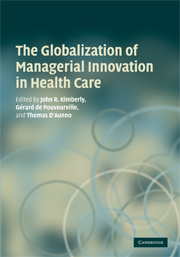Book contents
- Frontmatter
- Contents
- List of figures
- List of tables
- List of contributors
- Acknowledgements
- Introduction
- 1 Origins of DRGs in the United States: A technical, political and cultural story
- 2 Casemix in the United Kingdom: From development to plans
- 3 Casemix implementation in Portugal
- 4 From naïve hope to realistic conviction: DRGs in Sweden
- 5 Casemix in Denmark
- 6 DRGs in France
- 7 Introduction and use of DRGs in Belgium
- 8 DRGs in Germany: Introduction of a comprehensive, prospective DRG payment system by 2009
- 9 Casemix in Switzerland
- 10 The first decade of casemix in Italy
- 11 Casemix development and implementation in Australia
- 12 Diagnosis procedure combination: The Japanese approach to casemix
- 13 Casemix in Singapore
- 14 Experiences with the application of the DRG principle in Hungary
- 15 Casemix systems – past, present, and future: The Canadian experience
- 16 Conclusions: The global diffusion of casemix
- Index
- References
4 - From naïve hope to realistic conviction: DRGs in Sweden
Published online by Cambridge University Press: 24 February 2010
- Frontmatter
- Contents
- List of figures
- List of tables
- List of contributors
- Acknowledgements
- Introduction
- 1 Origins of DRGs in the United States: A technical, political and cultural story
- 2 Casemix in the United Kingdom: From development to plans
- 3 Casemix implementation in Portugal
- 4 From naïve hope to realistic conviction: DRGs in Sweden
- 5 Casemix in Denmark
- 6 DRGs in France
- 7 Introduction and use of DRGs in Belgium
- 8 DRGs in Germany: Introduction of a comprehensive, prospective DRG payment system by 2009
- 9 Casemix in Switzerland
- 10 The first decade of casemix in Italy
- 11 Casemix development and implementation in Australia
- 12 Diagnosis procedure combination: The Japanese approach to casemix
- 13 Casemix in Singapore
- 14 Experiences with the application of the DRG principle in Hungary
- 15 Casemix systems – past, present, and future: The Canadian experience
- 16 Conclusions: The global diffusion of casemix
- Index
- References
Summary
Introduction
Sweden, with about nine million inhabitants, has a decentralized public health care system. Three political and administrative levels – central government, county councils and local municipalities – are involved in financing, providing and evaluating health care activities. The central government has only a legislative supervisory role, while county councils and municipalities are responsible both for financing and providing health services (Figure 4.1). The county councils are entitled to collect direct income tax revenues as their major financial source, but they are also politically accountable through their directly elected political assemblies. The vast majority of Swedish hospitals are public, owned and financed by the county councils. Primary care settings are also financed by the county councils but they are both publicly and privately owned.
Swedish hospitals have traditionally been financed via global budgeting. This is due to the fact that Sweden has a tradition of publicly owned hospitals and that cost control has been an important issue. Moreover, before the introduction of DRGs, there was no accepted system in use to describe performance. The counties had poor knowledge of hospital activity and productivity. There was a great need to find ways to measure productivity.
In Sweden, DRGs have been used as a prospective payment system, to describe performance and increase the transparency of hospital activities, as an analyzing tool and to measure productivity.
- Type
- Chapter
- Information
- Publisher: Cambridge University PressPrint publication year: 2008



